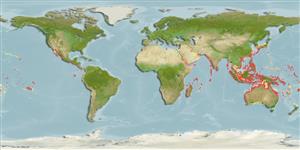Environment: milieu / climate zone / depth range / distribution range
Ecologie
marien rifbewoner; diepte 4 - 35 m (Ref. 90102). Tropical
Indo-West Pacific: Red Sea and East Africa to Fiji, north to southern Japan, south to southeast Australia and New Caledonia. Recently recorded from Tonga (Ref. 53797).
Grootte / Gewicht / Leeftijd
Maturity: Lm ? range ? - ? cm
Max length : 12.0 cm TL mannelijk / geslacht onbekend; (Ref. 2334)
Dorsale stekels (totaal): 5; Dorsale zachte stralen (totaal): 17-21; Anale stekels 0; Anale zachte stralen: 17 - 21; Wervels: 32 - 33. Post-pelagic are almost fully transparent and more slender compared to those established in the benthic phase. Variable in color from black to red and yellow, usually in a mix of bands and spots (Ref. 48635). Total body number of plates 31-35. Caudal fin truncate, rounded or lanceolate. Caudal fins of females modified into brood pouch (Ref. 9829).
Adults usually settle along reef edges in current-prone areas (Ref. 48635). Uncommon species found solitary or paired, among branches of gorgonians, floating weeds, or crinoids (Ref. 9710). They feed mostly on mysids but also target small benthic shrimps (Ref. 48635). Females carry the eggs in their pelvic fins that are modified to form a brood pouch (Ref. 205).
Levenscyclus en paargedrag
Maturiteit | Voortplanting | Paaien | Eieren | Fecunditeit | Larven
Pelvic fins of females are modified as brood pouch for the reception of the eggs (Ref. 205).
Randall, J.E., G.R. Allen and R.C. Steene, 1990. Fishes of the Great Barrier Reef and Coral Sea. University of Hawaii Press, Honolulu, Hawaii. 506 p. (Ref. 2334)
Status op de Rode Lijst van het IUCN (Ref. 130435)
Gevaar voor de mens
Harmless
Gebruik door de mens
Visserij: van geen belang; Aquarium: Publieke aquaria
Meer informatie
ReferentiesAquacultuurAquacultuurprofielKweeklijnenGeneticaElectrophoresesErfelijkheidZiektesVerwerkingNutrientsMassaconversie
Tools
Speciale rapporten
Download XML
Internetbronnen
Estimates based on models
Preferred temperature (Ref.
123201): 20.9 - 29, mean 27.7 °C (based on 626 cells).
Fylogenetische diversiteitsindex (Ref.
82804): PD
50 = 0.5312 [Uniqueness, from 0.5 = low to 2.0 = high].
Bayesian length-weight: a=0.01000 (0.00244 - 0.04107), b=3.04 (2.81 - 3.27), in cm total length, based on all LWR estimates for this body shape (Ref.
93245).
Trofisch niveau (Ref.
69278): 3.6 ±0.59 se; based on food items.
Fishing Vulnerability (Ref.
59153): Low vulnerability (10 of 100).
Nutrients (Ref.
124155): Calcium = 129 [75, 249] mg/100g; Iron = 0.917 [0.508, 1.656] mg/100g; Protein = 17.9 [16.7, 19.1] %; Omega3 = 0.123 [0.068, 0.224] g/100g; Selenium = 35.3 [16.7, 82.4] μg/100g; VitaminA = 90.1 [29.4, 266.4] μg/100g; Zinc = 1.93 [1.27, 2.76] mg/100g (wet weight);
